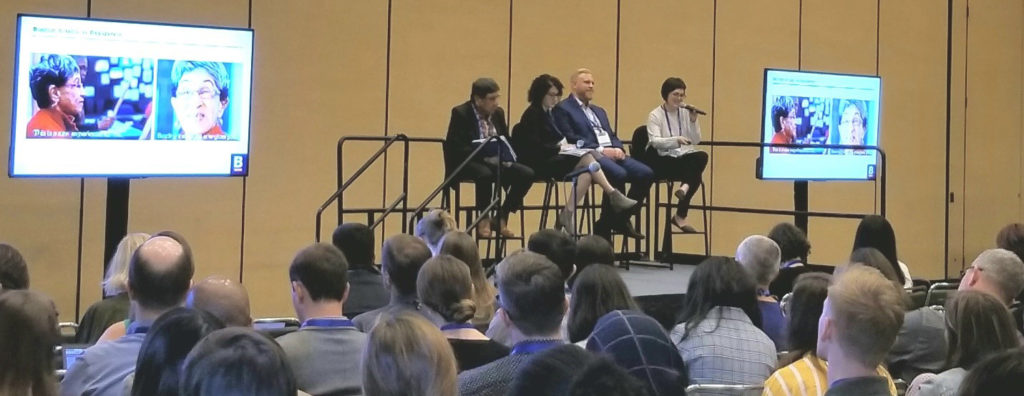Power of Culture Blog
Hosting Meaningful LCC Grant Receptions
Thoughtful event details can build community, spark collaboration, and amplify the impact of local arts and culture
Mina Kim, Program Officer
Notes from the American Planning Association’s Annual National Planning Conference, San Francisco, April 2019.

(l-r) Roberto Bedoya, Sakina Khan, Ryan Hand, and Kara Elliott-Ortega. Panelists in the Sharing Equity-driven Cultural Planning session.
Whom do we serve, and how well do we serve them? This question seemed to weigh on people’s minds at the recent annual National Planning Conference in San Francisco, where the theme of equity had a presence in so many of the sessions. Vijay Gupta, violinist and founder of Street Symphony, a nonprofit dedicated to providing music-making for individuals experiencing homelessness, incarceration, and poverty in the Los Angeles area, opened the conference with a call to action. To a roomful of over 800 planning officials, he urged everyone to reevaluate the narratives, worldviews, and systems prevalent in community development, while sharing his own story as a musician turned social justice activist.
Highlighting an early formative experience, Gupta described a performance at Patton State Hospital, where he played a classical program to an audience of patients who had been admitted for committing violent crimes and suffering from severe mental illness. Rather than receiving the expected applause, Gupta encountered silence, which was broken by an African American man in the audience who asked Gupta if he knew any songs that they might know. The man then started singing Jesus on the Mainline, a Freedom song sung during the Civil Rights Movement. It was this moment and subsequent acts of arts engagement with diverse audiences that made Gupta realize that people did not want music merely as entertainment, but as a way to see themselves; for those providing the music, the art, to see and understand the stories of people whom they ostensibly serve.
While the conference offered numerous panels on affordable housing, zoning, development incentives, and other topics in the planning field, these panels, as well as those focused on cultural planning, featured the important act of seeing. In Equity-driven Cultural Planning in Three Cities, Jennifer Erickson, Director of the Arts and Culture Department at the Metropolitan Area Planning Council, moderated a panel of planners from Oakland, Boston, and Washington, D.C. who discussed their cities’ respective approach to integrating culture, community, and equity. Sakina Khan, Deputy Director for Citywide Strategy and Analysis at the DC Office of Planning, shared her biggest takeaway from cultural planning efforts, which was learning the power of arts and culture as a facilitative tool in bringing people together and talking about their experiences in a way that more traditional methods of public engagement could not achieve. Kara Elliott-Ortega, Chief of Arts and Culture for Boston, also highlighted the immense community engagement process that went into, and continues around, the Boston Creates Cultural Plan, while Roberto Bedoya, Cultural Affairs Manager for the City of Oakland, underlined the essential need for people to experience a sense of belonging and recognition in any place-based initiative.

“This is everything,” Derek Santos of New Bedford Economic Development Council speaking of AHA! and arts and culture.
Other notable mentions of seeing through arts and culture appeared in Building the Civic Capacity Muscle, where Derek Santos, Executive Director of the New Bedford Economic Development Council spoke on New Bedford’s revitalization strategy. After detailing the city’s maritime history, fishing industry, and current demographics, Santos stopped on a photo of an AHA! dance program and exclaimed, “This is everything about New Bedford.” He continued to emphasize the arts and culture sector as an anchor to any citywide initiative and critical component to the city’s civic infrastructure. In Did My Taxes Pay for That?!, planners from three cities shared insights on the cross-sector partnerships, budget, artist selection, and community engagement processes that went into three different public art projects, including Communities of Opportunity Murals supported by the Greenville Housing Authority in South Carolina. Sean Scoopmire, Chair of the City of Greenville, South Carolina’s Art in Public Places Commission, described the organic community participation that evolved as youth from the community presented designs that they wanted to see in the neighborhood, which they painted with artist Adam Schrimmer.
Culture and community are intertwined, with each feeding into the other; neither can thrive in any meaningful way without individuals and institutions seeing and acknowledging the value of all those who make up our communities. At the Plan for Equity Forum, attendees had the opportunity to provide input on the APA’s Five Strategies for Diversity and Inclusion, in addition to making a commitment to how we each would move our community forward. My commitment to Mass Cultural Council’s Community Initiative and any work I pursue is to listen to and see the multiplicity of people shaping more a creative, humane, livable society. What is your commitment?